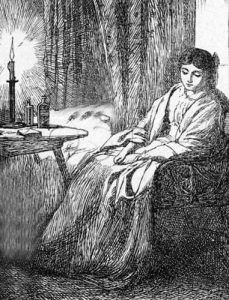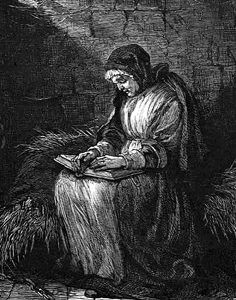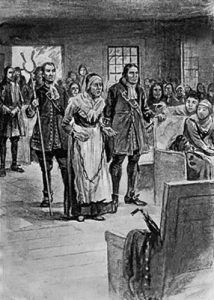Witches of Salem: Index A B C D E F-G H I-J K-N O-P Q-S T U-Z
Mary Foster Lacey, Sr. (1652-1707) – Born to Andrew Foster and Ann Alcock Foster in Andover, Massachusetts, on July 9, 1652, Mary would grow up to marry Lawrence Lacey on August 5, 1673. The couple would have two children. In 1692, when a woman named Elizabeth Ballard came down with a fever that baffled doctors, witchcraft was suspected, and a search for the responsible witch began. Two of the “afflicted girls” from Salem Village — Ann Putnam Jr. and Mary Walcott, were taken to Andover to seek out the witch and fell into fits at the sight of Ann Alcock Foster, Mary’s mother. Ann Alcock Foster was soon arrested, and it wouldn’t be long before Mary Lacey and her 18-year-old daughter would also be accused. The complaint was filed on July 19, 1692, by Joseph Ballard of Andover, alleging that both Mary Foster Lacey and her daughter were responsible for afflicting his wife, Elizabeth Ballard. When Mary was examined, she confessed to being a witch and also accused her mother, saying that they had both ridden upon a pole to a witch meeting in Salem Village. She also stated that several years previously, she had seen Mary Perkins Bradbury, Elizabeth Jackson Howe, and Rebecca Towne Nurse being baptized by the old Serpent at Newbury Falls. In addition to these women, she also implicated Richard Carrier and Andrew Carrier and confessed that she, herself, had afflicted Timothy Swan and Elizabeth Ballard.
Though her mother, Ann Alcock Foster, tried desperately to take all the blame to shield her daughter and granddaughter, ironically, those who confessed to being witches were not executed, many of those who denied having anything to do with the devil were hanged. Both Mary Foster Lacey and Ann Alcock Foster were tried on September 17, 1692, both were found guilty, and both were sentenced to execution. Though there were several others who were also tried that day, and their executions were carried out on September 22, 1692, the Foster women were not among them. All three were imprisoned. Mary Lacey, Jr. was released on bond in October 1692 and later found not guilty. Mary Foster Lacey, Sr. would be released in 1693 after the trials were discredited and ended. But, for Ann Alcock Foster, it was too late. After spending 21 weeks in prison, she died there on December 3, 1692. Mary Foster Lacey, Sr. would continue to live in Andover until her death on June 18, 1707.
Mary Lacey, Jr. (1674-17??) – Born to Lawrence and Mary Foster Lacey in Andover on May 24, 1674, Mary Jr. was 18 years old when she was accused of witchcraft. Her mother, Mary Foster Lacey, Sr., and grandmother, Ann Alcock Foster, were also accused. Both of her elders were found guilty and sentenced to be executed. However, they were not. Her mother was released in 1693 after the witch hysteria had ended. Unfortunately, her grandmother, Ann Alcock Foster, died in prison in December 1692. Mary Lacey, Jr. was released on bond in October 1692 and later found not guilty. She went on to marry Zerubbabel Kemp on January 27, 1703/04, in Groton, Massachusetts.
Jane Lilly – From Reading, Massachusetts, Jane Lilly was accused of witchcraft and examined along with Mary Colson on September 5, 1692. Lucky for Jane, her accusation occurred shortly before the entire witchcraft affair began to be questioned. In February 1693, she was examined in Charleston, Massachusetts. She was accused of afflicting Mary Marshall, wife of Edward Marshall of Malden, Massachusetts, as well as the typical “afflicted girls,” including Mary Warren, Elizabeth Booth, and several others, who went into dreadful fits when she entered the room. She was also accused of afflicting Susanna Post. In her examination, she said she knew nothing of the reasons behind the accusations. She admitted to sometimes visiting the Proctor’s house but denied ever having any type of inappropriate conference with either John Proctor or his wife, Elizabeth. Accusations were also made that she had a hand in the burning of William Hooper’s home, in which he died. Jane Lilly was indicted, imprisoned, and later cleared by proclamation.
Susanna North Martin (1621-1692) – Accused of witchcraft, the 71-year-old Widow Martin of Amesbury, Massachusetts, was one of the twenty men and women executed during the hysteria that gripped Salem, Massachusetts, in 1692. She was born to Richard North and Joan Bartram North and baptized in Olney, Buckinghamshire, England, on September 30, 1621. Her mother died when she was a child, and her father remarried a woman named Ursula. Somewhere along the line, the family went to the United States, settling in Salisbury, Massachusetts, around 1639. Susanna North grew up to marry the widower George Martin, a blacksmith, on August 11, 1646, at Salisbury. The couple would eventually have eight children.
Let Goody Martin rest in peace, I never knew her harm a fly,
And witch or not – God knows – not I?
I know who swore her life away;
And as God lives, I’d not condemn
An Indian dog on word of them.
— John Greenleaf Whittier
In 1654, George and Susanna moved to nearby Amesbury, where most of their children were born. Like many other accused witches, Susanna gained a reputation as a “troublemaker,” with locals saying that she was outspoken, defiant, and contemptuous of authority. In about 1647, while still living in Salisbury, she was fined 20 shillings for an unnamed offense. In about 1660, she was first accused of witchcraft by William Browne of Salisbury, alleging that she had been tormenting his wife, Elizabeth, with her spirit. There are no records of the results of this original accusation, but years later, during the witch hysteria of 1692, William Browne would testify that Susanna had driven his wife insane by witchcraft some 30 years earlier. Though nothing appears to have originally come of this first accusation, this was not the type of thing that was easily forgotten in Puritan New England. In 1667, records indicate that George Martin objected to Susanna’s seat placement in the meeting house. Her poor placement is indicative of how the locals felt about her.
On April 13, 1669, an official complaint of witchcraft was lodged against Susanna by a man named William Sargent Jr., who would say that he witnessed Susannah give birth to and kill an illegitimate baby. On that same day, George Martin filed suit for slander against William Sargent, Jr. for accusing his wife of fornication and infanticide. He also filed suit against William’s brother, Thomas Sargent, for saying that his son George Martin was a bastard and that his son Richard Martin was Goodwife Martin’s imp. George Martin would post a bond of £100 pounds so that Susannah could be released from jail, and the charges were eventually dropped. The slander charges against Thomas Sargent were also dropped, and though William Sargent, Jr. was found guilty of slander, the damage to Susanna’s reputation was already done.
In October 1669, George Martin was sued by Christopher Bartlett because Susanna had called him a liar and a thief. The verdict was against George and Susanna, but they had other problems to deal with. At that same court session, their son Richard was ” presented by the grand jury at the Salisbury Court, 1669, for abusing his father and throwing him down, taking away his clothes and holding up an ax against him.” The court found him guilty and sentenced Richard to be “whipped ten stripes.”
In 1671, George and Susanna (her sister Mary Jones would join them later) became involved in lengthy litigation over Susanna’s father’s estate. Both she and her sister Mary expected to inherit a large share of it. However, their stepmother produced what they considered a fake Will, which left almost all the estate to her. In October 1674, their inheritance would be lost when the court found against them. After her husband, George Martin, died in 1686, Susannah was left a poor widow. Being poor always made individuals susceptible to accusations. Her reputation as a troublemaker, her previous witchcraft accusation, and her litigious nature made her even more vulnerable.
In 1692, it comes as no surprise that she was one of those to be accused. She was arrested in Amesbury on May 2, having been accused of afflicting Mary Walcott, Abigail Williams, Ann Putnam, Jr., and Mercy Lewis of Salem Village. She was soon brought to Salem Towne to be questioned by Judge Hathorne and Judge Corwin. During her questioning, the “afflicted” girls would display fits, cry out, and say that they had attempted to recruit them into witchcraft. A number of other people would bear witness against her, including William Brown, John Pressey, Bernard Peach, and many others, including the infamous Thomas Putnam, Jr. Twice, she was required to undergo humiliating physical examinations in an effort to find a witch’s teet. During the entire process, Susanna quoted the Bible freely, something a witch was supposed to have been incapable of doing. Susannah North Martin was found guilty and hanged on July 19, 1692, in Salem Towne. Of her, the Reverend Cotton Mather would say: “This woman was one of the most impudent, scurrilous, wicked creatures of this world.” In 1711, the General Court granted compensation to many of the victims or their heirs, but Susanna’s children made no application to the authorities, and they received nothing. Susanna was not among those whose attainder was lifted.
Mary Osgood Marston (1665-1700) – Born to Christopher and Hannah Belknap Osgood on July 5, 1665, in Andover, Mary grew up to marry John Marston on May 28, 1689. Just three years later, she was one of the many in Andover to be accused of witchcraft. A complaint was filed against her on August 25, 1692, by Samuel Martin of Andover and Moses Tyler of Boxford for allegedly afflicting Abigail Martin and Rose Foster of Andover and Martha Sprague of Boxford. When she was examined, she made a full confession, admitting to seeing the “black man” and signing the Devil’s book. She was imprisoned. Her husband signed a petition on October 12, 1692, for her release, but it was to no avail. After she had spent some 20 weeks in jail, her case was finally brought to trial in early 1693. She was found not guilty and released after her husband paid all of the associated prison fees. She died of unknown causes at the age of 34 on April 5, 1700.
Sarah Murrell (1678-??) – The 14-year-old child of Peter and Mary Murrell of Beverly, young Sarah was charged with witchcraft along with several others on April 30, 1692. The complaint, filed by Jonathan Walcott and Thomas Putnam, Jr., alleged that she had afflicted Mary Walcott, Mercy Lewis, Abigail Williams, Ann Putnam, Jr., Elizabeth Hubbard, and Susanna Sheldon. The young girl was examined on May 2, 1692, and was taken to Boston’s jail the next day. Beyond her imprisonment, nothing more is known of her.
Rebecca Towne Nurse (1621–1692) – Probably the most famous of the Salem “witches,” she was one of three sisters accused and imprisoned for witchcraft. One of her sisters, Sarah Towne Cloyce, survived. However, Rebecca and her sister, Mary Towne Easty, were hanged during the Salem witch trials.
© Kathy Alexander/Legends of America, updated January 2024.
Also See:
The Salem Witchcraft Hysteria (Main article)
Procedures, Courts & Aftermath
Timeline of the Witchcraft Hysteria



